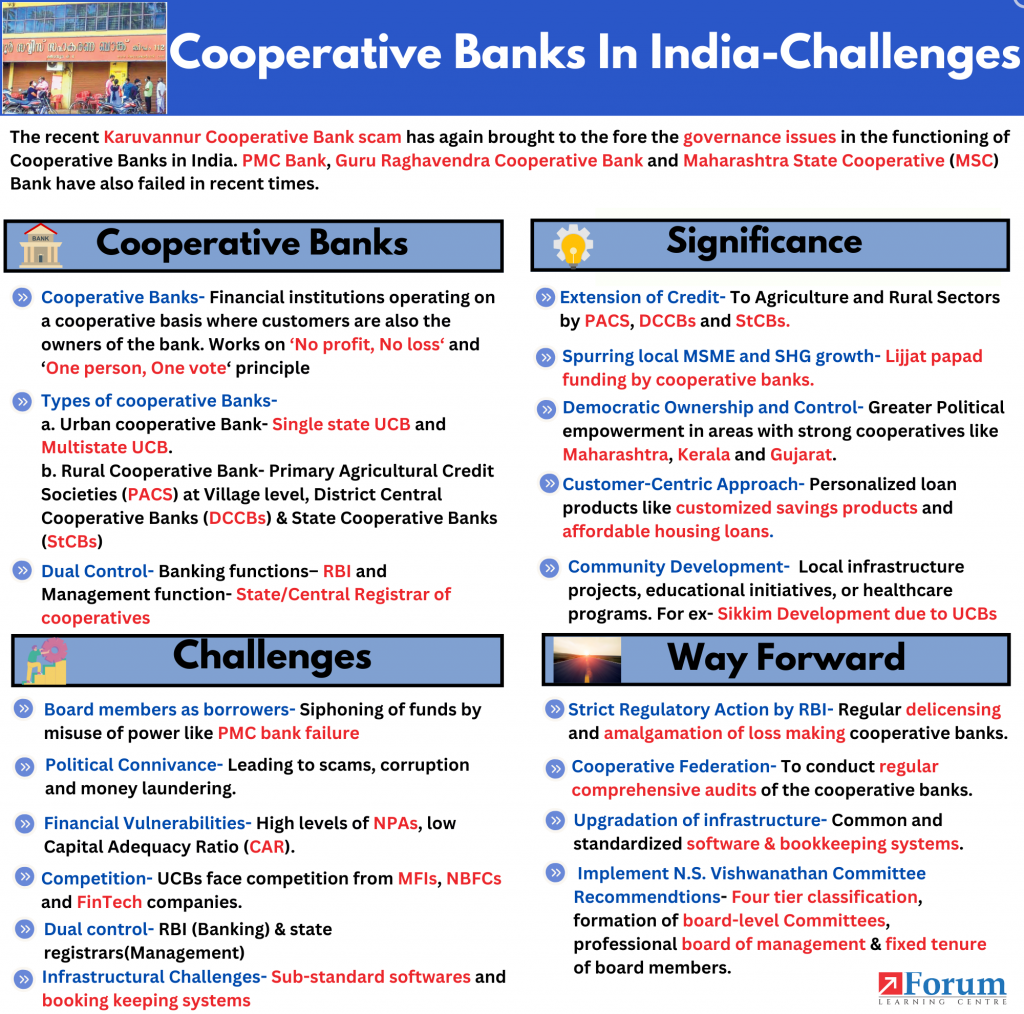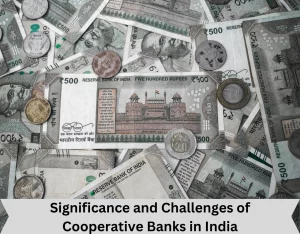ForumIAS announcing GS Foundation Program for UPSC CSE 2025-26 from 19 April. Click Here for more information.
Significance and Challenges of Cooperative Banks in India, The recent Karuvannur Cooperative Bank scam has again brought to the fore the governance issues in the functioning of Cooperative Banks in India. PMC Bank, Guru Raghavendra Cooperative Bank and Maharashtra State Cooperative (MSC) Bank have also failed in recent times. In this article, we will delve deep into the governance issues plaguing the cooperative banks in India.

What are Cooperative Banks? What is The Structure of Cooperative Banks in India?
Cooperative Banks- Cooperative banks in India are financial institutions that operate on a cooperative basis, where the customers are also the owners of the bank. Cooperative banks operate on the principle of ‘no profit, no loss‘ and ‘one person, one vote‘. According to the Reserve Bank of India (RBI), India had 1,502 urban co-operative banks as of March 2023.
Structure of Cooperative Banks in India
| Cooperative Banks In India | |||
| Urban Cooperative Banks | Rural Cooperative Banks | ||
| Scheduled | Non-Scheduled | Short Term | Long Term |
| 1. UCBs Operating in a single state a. Registered- State Cooperative Societies Act. b. Dual Control Banking functions– RBI under Banking Regulation Act 1949 (BRA 1949). Management functions– State registrar of Cooperative societies 2. Multistate UCBs a. Registered- Multi State Cooperative Societies Act, 2002. b. Dual Control Banking functions– RBI under Banking Regulation Act 1949. Management functions- Central Registrar of Cooperative societies. | 1. Primary Agricultural Credit Societies (PACS)- Village level- Not under RBI. No BRA 1949 applies. 2. Central Cooperative Banks (CCBs)- District level & State Cooperative Banks (StCBs)-State level a. Registered- State Cooperative Societies Act b. Dual Control Banking functions– RBI under Banking Regulation Act 1949. Inspection function has been delegated to NABARD by RBI under BRA 1949. Management function- State registrar of Cooperative societies | 1. Primary cooperative agriculture and Rural Development Banks (PCARDBs) 2. State Cooperative agriculture and Rural Development Banks (SCARDBs) | |
Importance of Cooperative Banks?
1. Extension of Credit to Agriculture and Rural Sectors- PACS, District Central Cooperative Banks (DCCBs) and State Cooperative Banks (SCBs) play a vital role in providing credit to farmers and supporting agricultural activities. They contribute significantly to the development of the rural economy.
2. Spurring local MSME and SHG growth- Urban Cooperative Banks (UCBs) cater to the financial needs of small and medium-sized businesses and individuals in urban and semi-urban areas. For Ex- Lijjat papad funding by cooperative banks.
3. Ownership and Control- Members of a credit cooperative society collectively decide on policies and elect the board of directors. This results in democratic ownership and control. For Ex- Greater Political empowerment in areas with strong cooperatives like Maharashtra, Kerala and Gujarat.
4. Customer-Centric Approach- Cooperative banks prioritize the needs of their members rather than maximizing profits. For ex- Personalized loan products like customized savings products, affordable housing loans tailored to the specific needs of their members.
5. Community Development- Cooperative banks support local infrastructure projects, educational initiatives, or healthcare programs. This involvement strengthens the socio-economic fabric of the community. For ex- Role of Cooperative Banks in development of Sikkim.
6. Risk Mitigation- Cooperative banks are slightly more resilient to economic downturns as they are not exposed to high-risk and high-value assets in comparison to commercial banks. For Ex- Resilience shown by UCBs during Global Financial Crisis 2008.
What are The Challenges of Cooperative Banks in India?
1. Financial Scams- Large number of big Cooperative banks have failed due to financial scams. For Ex- PMC Bank, Guru Raghavendra Cooperative Bank and Maharashtra State Cooperative (MSC) Bank have failed due to financial frauds.
2. Board members as borrowers- Cooperative bank board members can borrow from the banks, unlike the commercial bank board members. The board members in several cases have misused their borrowing powers to siphon off large sums of money, resulting in major cooperative bank failures. For Ex- PMC Bank Failure due to misuse of power by board.
3. Political Connivance and corruption- The board of the cooperative banks are dominated by the local politicians, who connive with local private financiers and real estate players to issue illegal loans and aid their black money transactions.
4. Financial Vulnerabilities- Cooperative Banks face financial vulnerabilities such as low capitalization, high levels of NPAs, low Capital Adequacy Ratio (CAR).
5. Challenges posed by other financial sector companies- Changes in the financial sector and evolution of Microfinance Institutions (MFIs), FinTech companies, Payment gateways, Non-Banking Financial Companies (NBFCs) have posed challenges to the Cooperative bank growth in terms of deposit and lending capabilities.
6. Regulatory Challenges- The dual control of cooperative banks- RBI in banking functions and the state government in management functions, has created regulatory ambiguities and uncertainties, in proper monitoring of cooperative banks.
7. Improper audit mechanism- Audits conducted by state department officials are irregular and lack comprehensiveness.
8. Infrastructural Challenges- The cooperative banks face logistical challenges like sub-standard softwares and sub-standard booking keeping systems, which has made these banks susceptible to frauds.
7. Governance Challenges- The small size, scattered nature and the lack of a unified brand and policy for cooperative banks makes it difficult for the watchdogs to effectively govern these banks.
| Read More- Punjab and Maharashtra Cooperative (PMC) Bank crisis |
What should Be The Way forward?
1. Strict Regulatory Action by RBI- RBI must be stringent in its regulatory oversight by focussing on regular delicensing and the shrinkage or compulsory amalgamation of loss making cooperative banks.
2. Cooperative Federation- A cooperative federation must be formed to conduct regular comprehensive audits of the cooperative banks.
3. Upgradation of infrastructure- The provisions must be made for a common, standardized software, standardized bookkeeping systems. These must be linked to a central database for proper financial monitoring using artificial intelligence and pattern recognition.
4. Remove political influence- There is a need to bring in new people, young people and professionals in managerial roles, who will take cooperative banks forward.
5. Implement the recommendations of N.S. Vishwanathan Committee- Four tier classification (Tier 1 (having deposits up to Rs 100 crore), Tier 2 (deposits between Rs 100 crore and Rs 1,000 crore), Tier 3 (deposits between Rs 1,000 crore and Rs 10,000 crore), Tier 4 (deposits more than Rs 10,000 crore)), formation of board-level Committees, constitution of professional board of management and fixed tenure of board members recommended by the committee must be implemented at the earliest.
6. Implement recommendation of R Gandhi Committee- Conversion of Urban Cooperative Banks (UCBs) with business size of 20,000 crore rupees or more into regular banks.
| Read More- Livemint UPSC Syllabus- GS 3- Banking sector (Indian Economy) |





